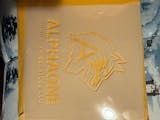Using a stencil on a curvy 3D surface can get difficult. Especially with an object like a mug, in which painting the design with precision is highly important.
Many problems could arise. You could struggle with the angle of the design being transferred to the mug. The paint itself can slip off as well, and there’s much more. So, stencils can make your life much easier compared to painting the mug freehand.
For stencil-painting a mug, the smaller the stencil, the better. It is also essential that the template is curvy enough to cover the mug easily. Other tips include using a sponge to avoid leaving marks, and much more!

1 Keep the stencil small
First things first, you need to get a small stencil. While mugs are already tiny objects compared to other surfaces, working with smaller stencils is nonetheless an advantage.
If you take a bigger stencil, you will find it harder to bend. Moreover, it will give you little flexibility over how much surface of the mug you cover with your painting.
2 Choose the right painting medium
The surface of a mug is very smooth and slippery. Not all types of paints will work on it. Paints that aren’t waterproof are out of the question, of course. But you would also need to select a type of paint that’s also scratch-resistant.
And that’s hard because ultimately, all painting mediums would either leave bubbles or get smudged off. And if you’re going for markers, choose oil-based ones like those by Sharpies. They spread easily, in the same way as paints, so they’re not that difficult to manage!
3 Use a sponge instead of a brush
Now let’s say you like the texture of normal plasticizing paints and want to use the mug as a decor piece only. In that case, you can opt for acrylic paints, or even glass or ceramic-based paints.
But along with that, you would also need to consider a suitable applicator. So instead of a brush, you can use a soft sponge. Use light pressure when pressing against the stencil. Also, remember to let the paint dry before removing the stencil.
4 Prep the mug by priming and sanding
One of the best methods to prepare the mug’s surface is to prime it. Before you begin, make sure that it’s completely clean. Take a cotton ball dipped in alcohol and completely rub the surface of the mug.
You can also use a paint primer such as one that’s designed for acrylic paints. Use 400 grit fine sandpaper over the mug’s painted and unpainted surface to make them even and flat.
Using sandpaper also helps in getting the paint to stick to the mug. Note that you will have to face a lot of dust. So again, use an alcohol dipped cotton ball or rag to wipe it clean. You can even do it with a dry cloth but it might not be as effective.
5 Protect your mug
Handling a mug can be tricky whilst painting! So what you need to do is block all the exposed areas that you wouldn’t be working on. You can use painter’s tape or brown paper or any sort of wrapping at all.
The reason is simple: Mugs are slippery and during painting, your hand might slip. Even if you don’t end up breaking the mug, you can pretty much ruin the design. In case you end up making a mess, you’d need to spend extra time and effort to permanently remove the excess paint in all the unwanted areas!
6 Keep the paint thick
You will have a problem sticking down the paint in thin layers on the mug. Thinned-down paint isn’t ideal for slippery surfaces. Your best bet is to apply thick paint as the thin layer will be removed immediately upon pulling the stencil. Even if you use ceramic paint, it’s ideal to keep the layers thick. The paint will get smoother as it dries but some marks would still be visible.
7 Keep touch-ups
To tell the truth, your first result may not be smooth. You’ll be tempted to make a few changes, so use tiny brushes for that. You can dip the paint into the brush and blend it in with the painted stencil design that already exists on the mug.
Remember that if you have any tiny marks, they can easily be scraped away by applying more pressure to the mug with the brush.
8 Let the mug dry
You need to leave the mug for at least 24 hours to fully dry. Make sure it’s in a nice and dry place, with no dust around. To make the paint permanent, you’ll have to bake the mug in your oven. That’s the only way to make it ready for food use.
This method is known as ‘curing’ and it may vary from one paint brand to another. Typically, porcelain paints come with proper full and proper instructions related to baking. Just make sure to keep an eye out for any fumes that might appear during the process. You wouldn’t want to damage your mug!
Conclusion
So make sure your mug is clean before you begin painting. Rub it with a cotton ball dipped in alcohol. It’s best to use a small stencil, never go for a bigger design as it will cause trouble covering the area precisely while painting.
When painting the mug, it’s best to use a sponge rather than a brush. The latter will leave marks all over the place, which can look untidy. You can also use smaller brushes to make minor touch-ups. Finally, look forward to your paint or marker instructions for baking the mug to make it food and microwave safe.
Also, don’t forget to check out our custom stencil services to get the best size for stencil-painting your mug. From illustrations and animals, we have all types of stencils that you could use for your mug painting!







